A Report on the Effects of Pesticides on Human Health and Safety
VerifiedAdded on 2020/07/22
|9
|2268
|256
Report
AI Summary
This report examines the adverse effects of pesticides on human health, encompassing toxicology, exposure pathways, and various health impacts. The report defines pesticides, detailing their use and types like insecticides, herbicides, and fungicides. It explores multiple exposure routes, including food, water, inhalation, and dermal contact, emphasizing the significant risks for children. The main body of the report discusses the negative health effects, such as respiratory issues, cancer, neurological problems, and hormone disruption, with examples like endometriosis and birth defects. The report also explores the safety measures taken by governments and the use of organic pesticides like soap spray, cayenne pepper spray, tobacco, pyrethrin, and neem to reduce harm. The conclusion summarizes the key findings, emphasizing the importance of understanding pesticide effects and adopting safer alternatives.
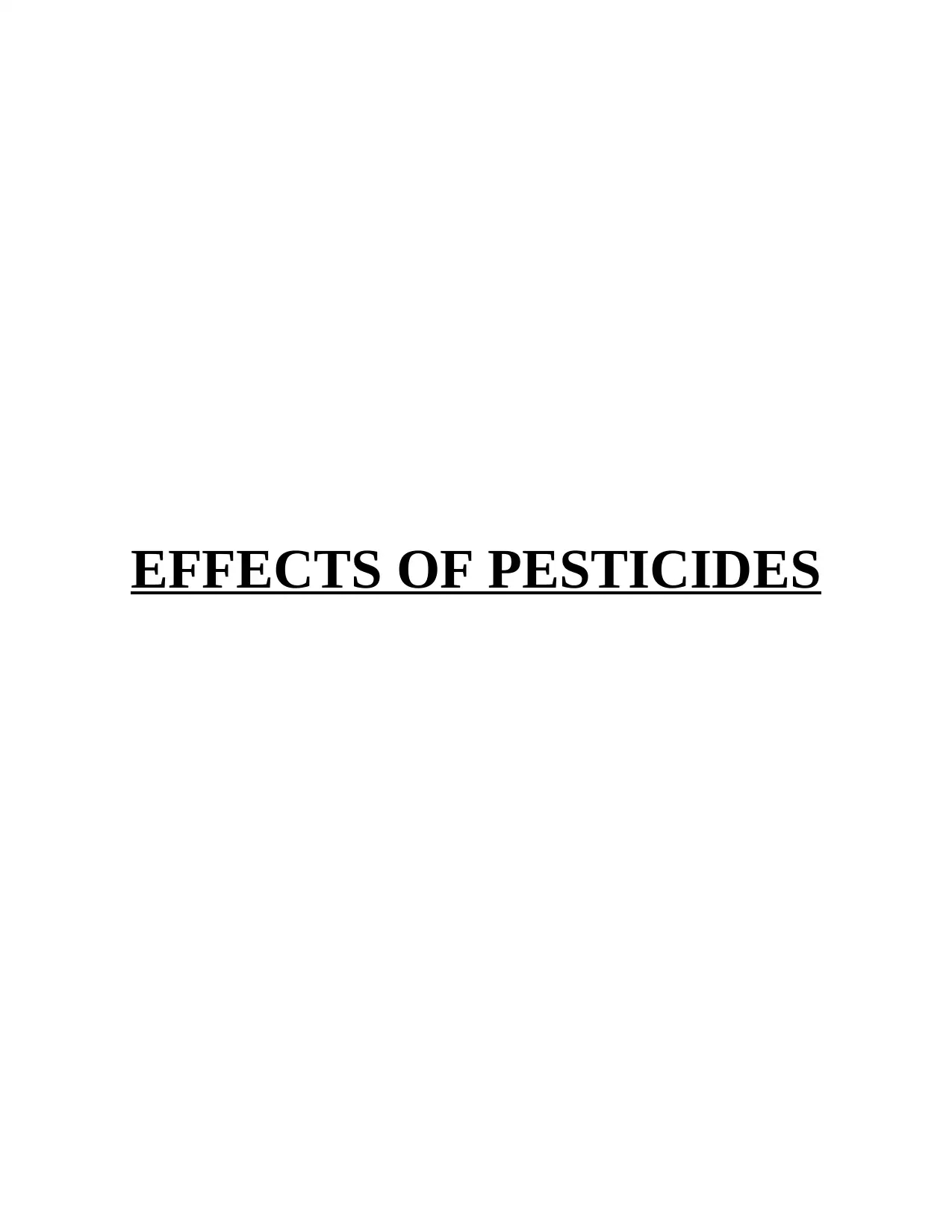
EFFECTS OF PESTICIDES
Paraphrase This Document
Need a fresh take? Get an instant paraphrase of this document with our AI Paraphraser
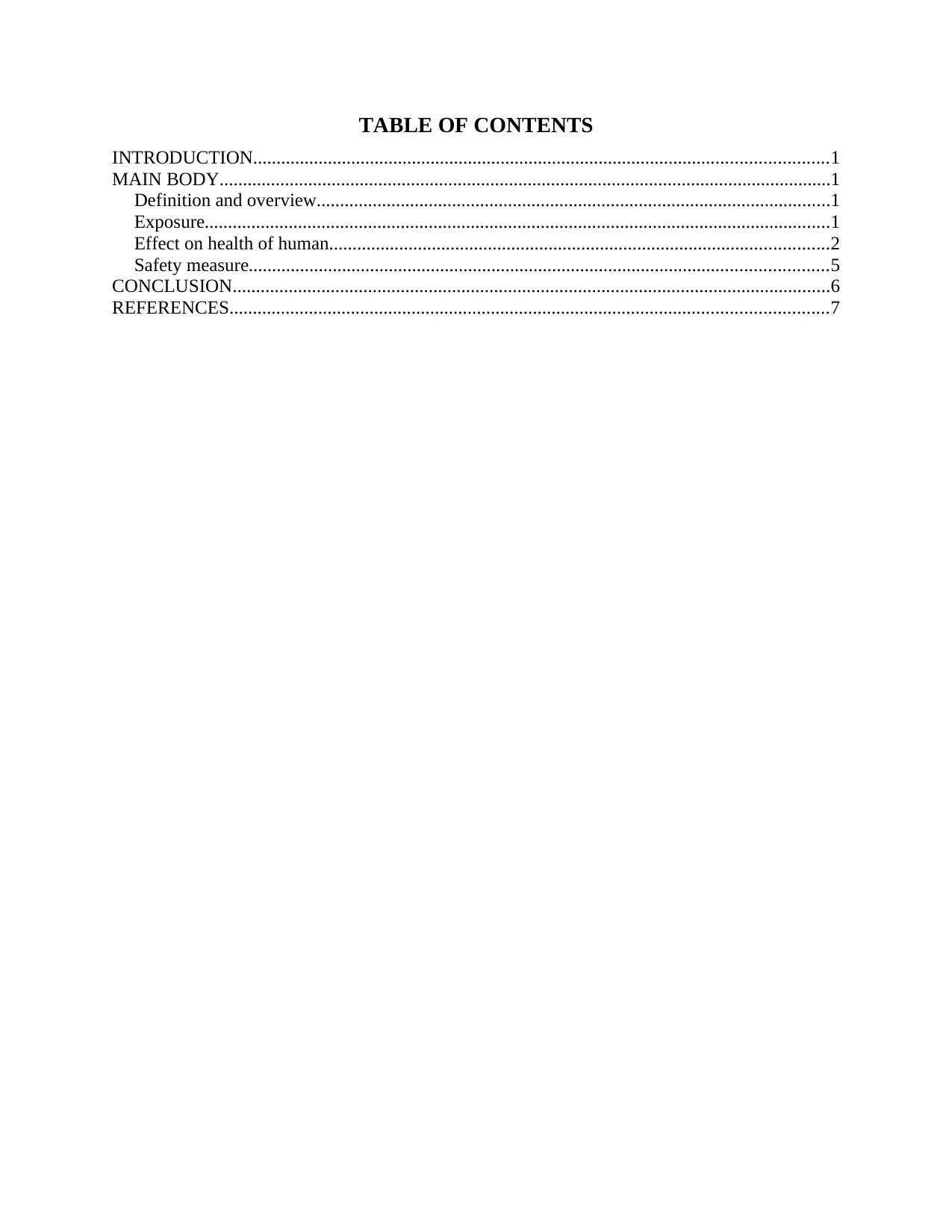
TABLE OF CONTENTS
INTRODUCTION...........................................................................................................................1
MAIN BODY...................................................................................................................................1
Definition and overview..............................................................................................................1
Exposure......................................................................................................................................1
Effect on health of human...........................................................................................................2
Safety measure............................................................................................................................5
CONCLUSION................................................................................................................................6
REFERENCES................................................................................................................................7
INTRODUCTION...........................................................................................................................1
MAIN BODY...................................................................................................................................1
Definition and overview..............................................................................................................1
Exposure......................................................................................................................................1
Effect on health of human...........................................................................................................2
Safety measure............................................................................................................................5
CONCLUSION................................................................................................................................6
REFERENCES................................................................................................................................7
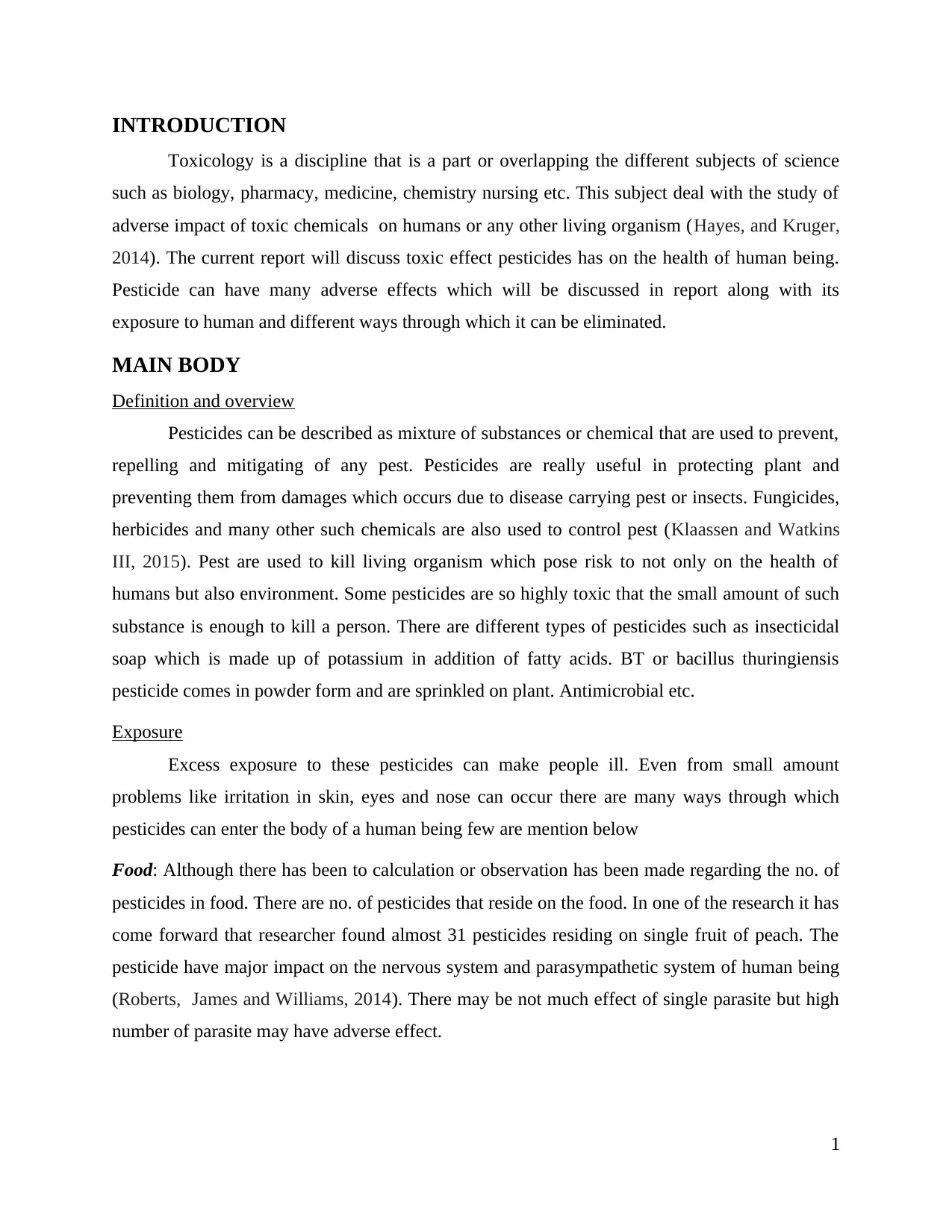
INTRODUCTION
Toxicology is a discipline that is a part or overlapping the different subjects of science
such as biology, pharmacy, medicine, chemistry nursing etc. This subject deal with the study of
adverse impact of toxic chemicals on humans or any other living organism (Hayes, and Kruger,
2014). The current report will discuss toxic effect pesticides has on the health of human being.
Pesticide can have many adverse effects which will be discussed in report along with its
exposure to human and different ways through which it can be eliminated.
MAIN BODY
Definition and overview
Pesticides can be described as mixture of substances or chemical that are used to prevent,
repelling and mitigating of any pest. Pesticides are really useful in protecting plant and
preventing them from damages which occurs due to disease carrying pest or insects. Fungicides,
herbicides and many other such chemicals are also used to control pest (Klaassen and Watkins
III, 2015). Pest are used to kill living organism which pose risk to not only on the health of
humans but also environment. Some pesticides are so highly toxic that the small amount of such
substance is enough to kill a person. There are different types of pesticides such as insecticidal
soap which is made up of potassium in addition of fatty acids. BT or bacillus thuringiensis
pesticide comes in powder form and are sprinkled on plant. Antimicrobial etc.
Exposure
Excess exposure to these pesticides can make people ill. Even from small amount
problems like irritation in skin, eyes and nose can occur there are many ways through which
pesticides can enter the body of a human being few are mention below
Food: Although there has been to calculation or observation has been made regarding the no. of
pesticides in food. There are no. of pesticides that reside on the food. In one of the research it has
come forward that researcher found almost 31 pesticides residing on single fruit of peach. The
pesticide have major impact on the nervous system and parasympathetic system of human being
(Roberts, James and Williams, 2014). There may be not much effect of single parasite but high
number of parasite may have adverse effect.
1
Toxicology is a discipline that is a part or overlapping the different subjects of science
such as biology, pharmacy, medicine, chemistry nursing etc. This subject deal with the study of
adverse impact of toxic chemicals on humans or any other living organism (Hayes, and Kruger,
2014). The current report will discuss toxic effect pesticides has on the health of human being.
Pesticide can have many adverse effects which will be discussed in report along with its
exposure to human and different ways through which it can be eliminated.
MAIN BODY
Definition and overview
Pesticides can be described as mixture of substances or chemical that are used to prevent,
repelling and mitigating of any pest. Pesticides are really useful in protecting plant and
preventing them from damages which occurs due to disease carrying pest or insects. Fungicides,
herbicides and many other such chemicals are also used to control pest (Klaassen and Watkins
III, 2015). Pest are used to kill living organism which pose risk to not only on the health of
humans but also environment. Some pesticides are so highly toxic that the small amount of such
substance is enough to kill a person. There are different types of pesticides such as insecticidal
soap which is made up of potassium in addition of fatty acids. BT or bacillus thuringiensis
pesticide comes in powder form and are sprinkled on plant. Antimicrobial etc.
Exposure
Excess exposure to these pesticides can make people ill. Even from small amount
problems like irritation in skin, eyes and nose can occur there are many ways through which
pesticides can enter the body of a human being few are mention below
Food: Although there has been to calculation or observation has been made regarding the no. of
pesticides in food. There are no. of pesticides that reside on the food. In one of the research it has
come forward that researcher found almost 31 pesticides residing on single fruit of peach. The
pesticide have major impact on the nervous system and parasympathetic system of human being
(Roberts, James and Williams, 2014). There may be not much effect of single parasite but high
number of parasite may have adverse effect.
1
⊘ This is a preview!⊘
Do you want full access?
Subscribe today to unlock all pages.

Trusted by 1+ million students worldwide
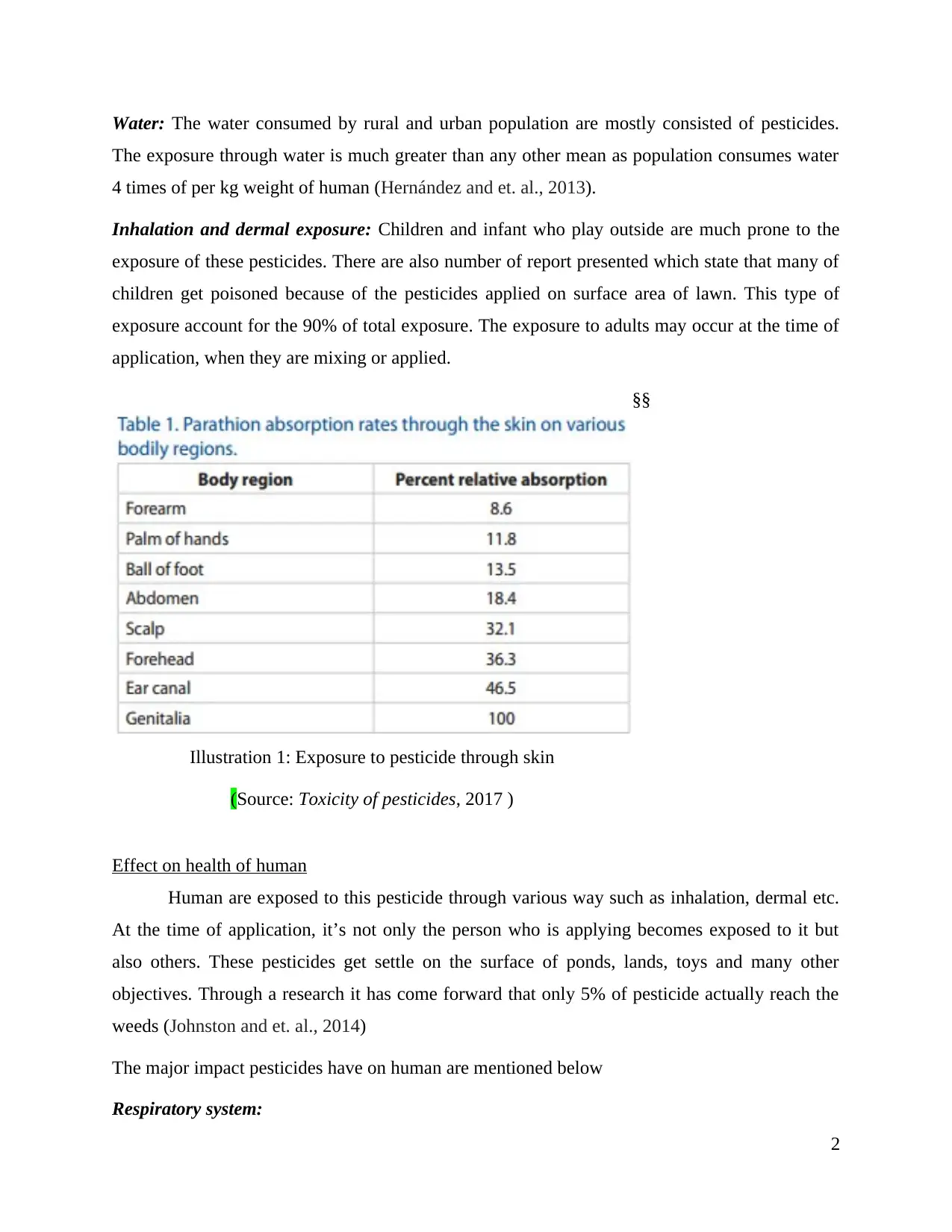
Water: The water consumed by rural and urban population are mostly consisted of pesticides.
The exposure through water is much greater than any other mean as population consumes water
4 times of per kg weight of human (Hernández and et. al., 2013).
Inhalation and dermal exposure: Children and infant who play outside are much prone to the
exposure of these pesticides. There are also number of report presented which state that many of
children get poisoned because of the pesticides applied on surface area of lawn. This type of
exposure account for the 90% of total exposure. The exposure to adults may occur at the time of
application, when they are mixing or applied.
Illustration 1: Exposure to pesticide through skin
(Source: Toxicity of pesticides, 2017 )
§§
Effect on health of human
Human are exposed to this pesticide through various way such as inhalation, dermal etc.
At the time of application, it’s not only the person who is applying becomes exposed to it but
also others. These pesticides get settle on the surface of ponds, lands, toys and many other
objectives. Through a research it has come forward that only 5% of pesticide actually reach the
weeds (Johnston and et. al., 2014)
The major impact pesticides have on human are mentioned below
Respiratory system:
2
The exposure through water is much greater than any other mean as population consumes water
4 times of per kg weight of human (Hernández and et. al., 2013).
Inhalation and dermal exposure: Children and infant who play outside are much prone to the
exposure of these pesticides. There are also number of report presented which state that many of
children get poisoned because of the pesticides applied on surface area of lawn. This type of
exposure account for the 90% of total exposure. The exposure to adults may occur at the time of
application, when they are mixing or applied.
Illustration 1: Exposure to pesticide through skin
(Source: Toxicity of pesticides, 2017 )
§§
Effect on health of human
Human are exposed to this pesticide through various way such as inhalation, dermal etc.
At the time of application, it’s not only the person who is applying becomes exposed to it but
also others. These pesticides get settle on the surface of ponds, lands, toys and many other
objectives. Through a research it has come forward that only 5% of pesticide actually reach the
weeds (Johnston and et. al., 2014)
The major impact pesticides have on human are mentioned below
Respiratory system:
2
Paraphrase This Document
Need a fresh take? Get an instant paraphrase of this document with our AI Paraphraser
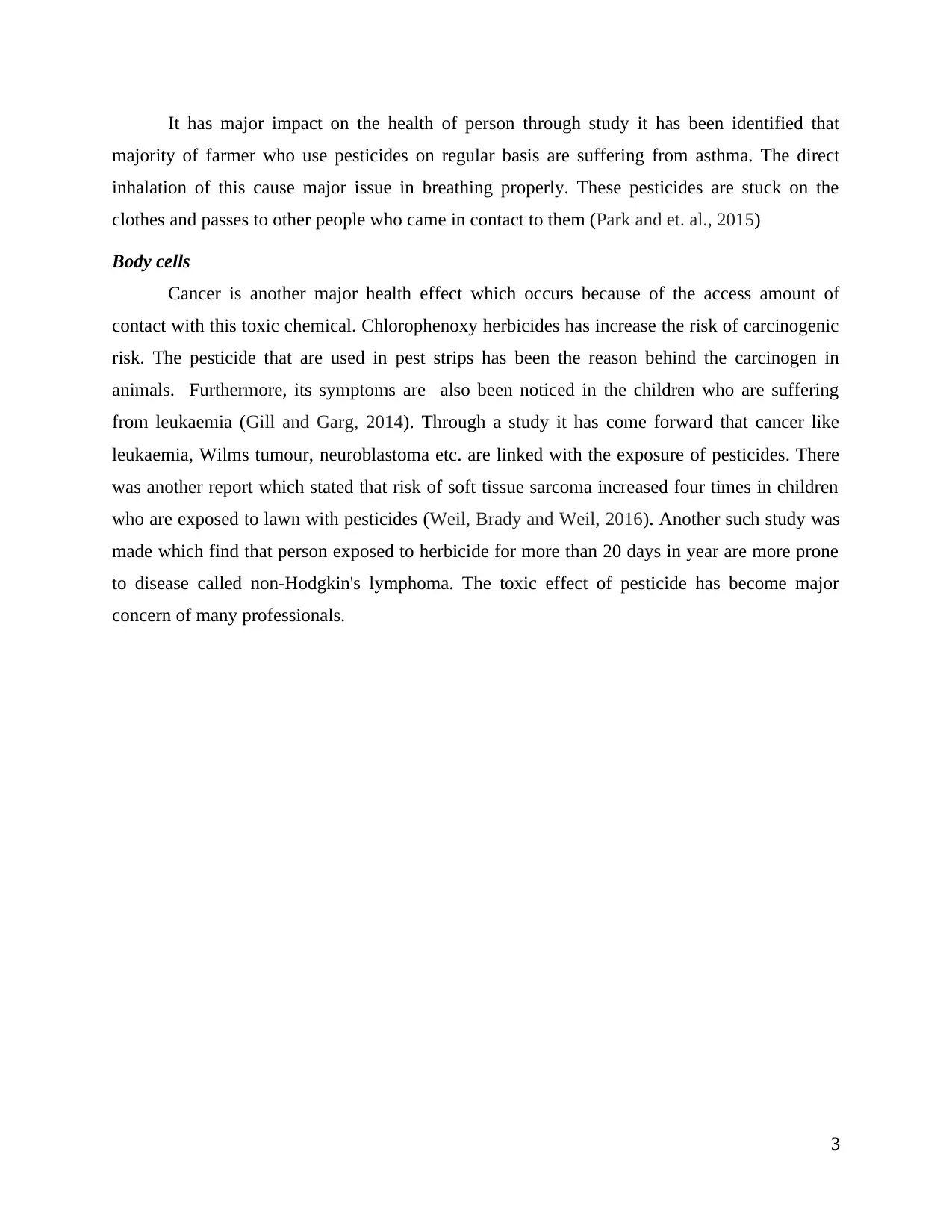
It has major impact on the health of person through study it has been identified that
majority of farmer who use pesticides on regular basis are suffering from asthma. The direct
inhalation of this cause major issue in breathing properly. These pesticides are stuck on the
clothes and passes to other people who came in contact to them (Park and et. al., 2015)
Body cells
Cancer is another major health effect which occurs because of the access amount of
contact with this toxic chemical. Chlorophenoxy herbicides has increase the risk of carcinogenic
risk. The pesticide that are used in pest strips has been the reason behind the carcinogen in
animals. Furthermore, its symptoms are also been noticed in the children who are suffering
from leukaemia (Gill and Garg, 2014). Through a study it has come forward that cancer like
leukaemia, Wilms tumour, neuroblastoma etc. are linked with the exposure of pesticides. There
was another report which stated that risk of soft tissue sarcoma increased four times in children
who are exposed to lawn with pesticides (Weil, Brady and Weil, 2016). Another such study was
made which find that person exposed to herbicide for more than 20 days in year are more prone
to disease called non-Hodgkin's lymphoma. The toxic effect of pesticide has become major
concern of many professionals.
3
majority of farmer who use pesticides on regular basis are suffering from asthma. The direct
inhalation of this cause major issue in breathing properly. These pesticides are stuck on the
clothes and passes to other people who came in contact to them (Park and et. al., 2015)
Body cells
Cancer is another major health effect which occurs because of the access amount of
contact with this toxic chemical. Chlorophenoxy herbicides has increase the risk of carcinogenic
risk. The pesticide that are used in pest strips has been the reason behind the carcinogen in
animals. Furthermore, its symptoms are also been noticed in the children who are suffering
from leukaemia (Gill and Garg, 2014). Through a study it has come forward that cancer like
leukaemia, Wilms tumour, neuroblastoma etc. are linked with the exposure of pesticides. There
was another report which stated that risk of soft tissue sarcoma increased four times in children
who are exposed to lawn with pesticides (Weil, Brady and Weil, 2016). Another such study was
made which find that person exposed to herbicide for more than 20 days in year are more prone
to disease called non-Hodgkin's lymphoma. The toxic effect of pesticide has become major
concern of many professionals.
3
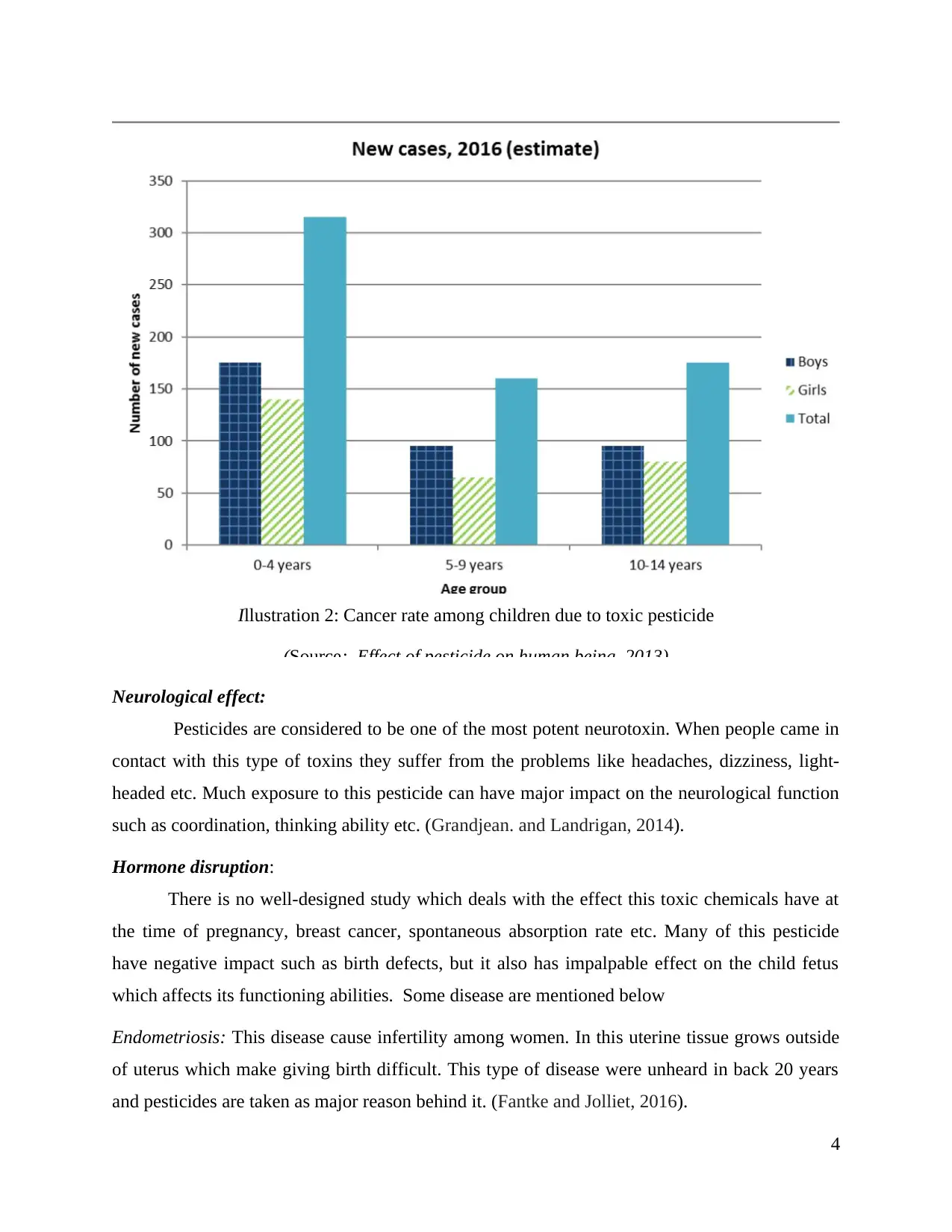
Illustration 2: Cancer rate among children due to toxic pesticide
(Source: Effect of pesticide on human being, 2013)
Neurological effect:
Pesticides are considered to be one of the most potent neurotoxin. When people came in
contact with this type of toxins they suffer from the problems like headaches, dizziness, light-
headed etc. Much exposure to this pesticide can have major impact on the neurological function
such as coordination, thinking ability etc. (Grandjean. and Landrigan, 2014).
Hormone disruption:
There is no well-designed study which deals with the effect this toxic chemicals have at
the time of pregnancy, breast cancer, spontaneous absorption rate etc. Many of this pesticide
have negative impact such as birth defects, but it also has impalpable effect on the child fetus
which affects its functioning abilities. Some disease are mentioned below
Endometriosis: This disease cause infertility among women. In this uterine tissue grows outside
of uterus which make giving birth difficult. This type of disease were unheard in back 20 years
and pesticides are taken as major reason behind it. (Fantke and Jolliet, 2016).
4
(Source: Effect of pesticide on human being, 2013)
Neurological effect:
Pesticides are considered to be one of the most potent neurotoxin. When people came in
contact with this type of toxins they suffer from the problems like headaches, dizziness, light-
headed etc. Much exposure to this pesticide can have major impact on the neurological function
such as coordination, thinking ability etc. (Grandjean. and Landrigan, 2014).
Hormone disruption:
There is no well-designed study which deals with the effect this toxic chemicals have at
the time of pregnancy, breast cancer, spontaneous absorption rate etc. Many of this pesticide
have negative impact such as birth defects, but it also has impalpable effect on the child fetus
which affects its functioning abilities. Some disease are mentioned below
Endometriosis: This disease cause infertility among women. In this uterine tissue grows outside
of uterus which make giving birth difficult. This type of disease were unheard in back 20 years
and pesticides are taken as major reason behind it. (Fantke and Jolliet, 2016).
4
⊘ This is a preview!⊘
Do you want full access?
Subscribe today to unlock all pages.

Trusted by 1+ million students worldwide
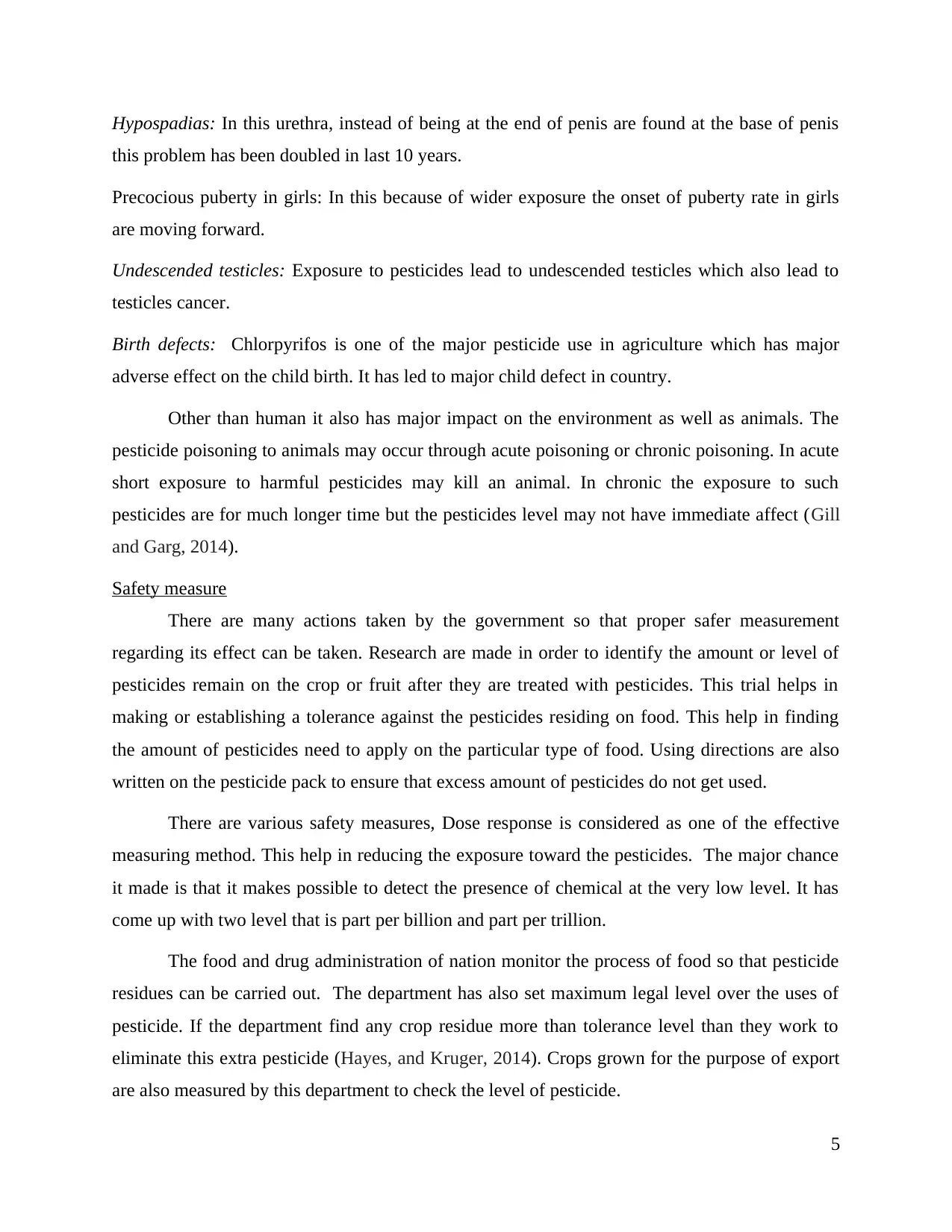
Hypospadias: In this urethra, instead of being at the end of penis are found at the base of penis
this problem has been doubled in last 10 years.
Precocious puberty in girls: In this because of wider exposure the onset of puberty rate in girls
are moving forward.
Undescended testicles: Exposure to pesticides lead to undescended testicles which also lead to
testicles cancer.
Birth defects: Chlorpyrifos is one of the major pesticide use in agriculture which has major
adverse effect on the child birth. It has led to major child defect in country.
Other than human it also has major impact on the environment as well as animals. The
pesticide poisoning to animals may occur through acute poisoning or chronic poisoning. In acute
short exposure to harmful pesticides may kill an animal. In chronic the exposure to such
pesticides are for much longer time but the pesticides level may not have immediate affect (Gill
and Garg, 2014).
Safety measure
There are many actions taken by the government so that proper safer measurement
regarding its effect can be taken. Research are made in order to identify the amount or level of
pesticides remain on the crop or fruit after they are treated with pesticides. This trial helps in
making or establishing a tolerance against the pesticides residing on food. This help in finding
the amount of pesticides need to apply on the particular type of food. Using directions are also
written on the pesticide pack to ensure that excess amount of pesticides do not get used.
There are various safety measures, Dose response is considered as one of the effective
measuring method. This help in reducing the exposure toward the pesticides. The major chance
it made is that it makes possible to detect the presence of chemical at the very low level. It has
come up with two level that is part per billion and part per trillion.
The food and drug administration of nation monitor the process of food so that pesticide
residues can be carried out. The department has also set maximum legal level over the uses of
pesticide. If the department find any crop residue more than tolerance level than they work to
eliminate this extra pesticide (Hayes, and Kruger, 2014). Crops grown for the purpose of export
are also measured by this department to check the level of pesticide.
5
this problem has been doubled in last 10 years.
Precocious puberty in girls: In this because of wider exposure the onset of puberty rate in girls
are moving forward.
Undescended testicles: Exposure to pesticides lead to undescended testicles which also lead to
testicles cancer.
Birth defects: Chlorpyrifos is one of the major pesticide use in agriculture which has major
adverse effect on the child birth. It has led to major child defect in country.
Other than human it also has major impact on the environment as well as animals. The
pesticide poisoning to animals may occur through acute poisoning or chronic poisoning. In acute
short exposure to harmful pesticides may kill an animal. In chronic the exposure to such
pesticides are for much longer time but the pesticides level may not have immediate affect (Gill
and Garg, 2014).
Safety measure
There are many actions taken by the government so that proper safer measurement
regarding its effect can be taken. Research are made in order to identify the amount or level of
pesticides remain on the crop or fruit after they are treated with pesticides. This trial helps in
making or establishing a tolerance against the pesticides residing on food. This help in finding
the amount of pesticides need to apply on the particular type of food. Using directions are also
written on the pesticide pack to ensure that excess amount of pesticides do not get used.
There are various safety measures, Dose response is considered as one of the effective
measuring method. This help in reducing the exposure toward the pesticides. The major chance
it made is that it makes possible to detect the presence of chemical at the very low level. It has
come up with two level that is part per billion and part per trillion.
The food and drug administration of nation monitor the process of food so that pesticide
residues can be carried out. The department has also set maximum legal level over the uses of
pesticide. If the department find any crop residue more than tolerance level than they work to
eliminate this extra pesticide (Hayes, and Kruger, 2014). Crops grown for the purpose of export
are also measured by this department to check the level of pesticide.
5
Paraphrase This Document
Need a fresh take? Get an instant paraphrase of this document with our AI Paraphraser
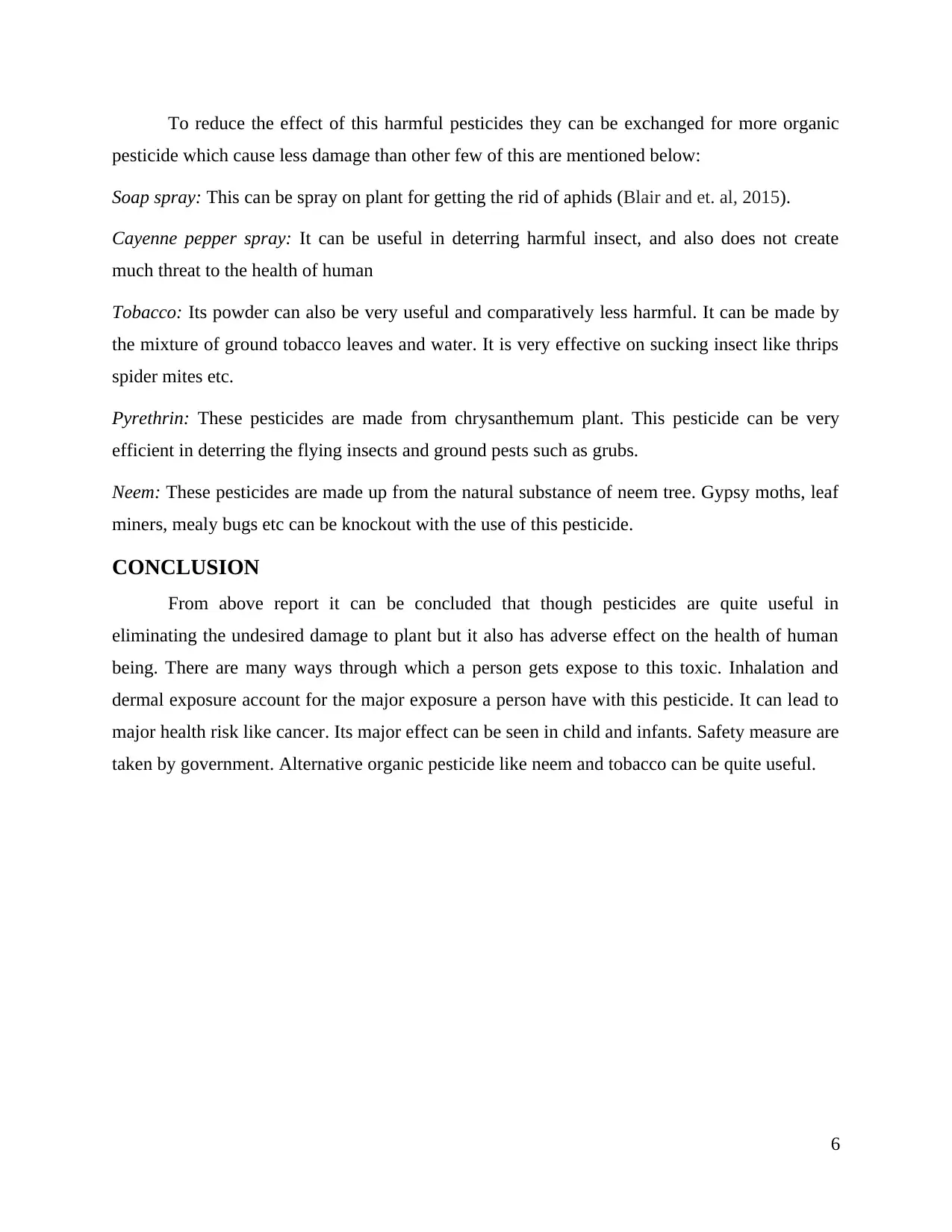
To reduce the effect of this harmful pesticides they can be exchanged for more organic
pesticide which cause less damage than other few of this are mentioned below:
Soap spray: This can be spray on plant for getting the rid of aphids (Blair and et. al, 2015).
Cayenne pepper spray: It can be useful in deterring harmful insect, and also does not create
much threat to the health of human
Tobacco: Its powder can also be very useful and comparatively less harmful. It can be made by
the mixture of ground tobacco leaves and water. It is very effective on sucking insect like thrips
spider mites etc.
Pyrethrin: These pesticides are made from chrysanthemum plant. This pesticide can be very
efficient in deterring the flying insects and ground pests such as grubs.
Neem: These pesticides are made up from the natural substance of neem tree. Gypsy moths, leaf
miners, mealy bugs etc can be knockout with the use of this pesticide.
CONCLUSION
From above report it can be concluded that though pesticides are quite useful in
eliminating the undesired damage to plant but it also has adverse effect on the health of human
being. There are many ways through which a person gets expose to this toxic. Inhalation and
dermal exposure account for the major exposure a person have with this pesticide. It can lead to
major health risk like cancer. Its major effect can be seen in child and infants. Safety measure are
taken by government. Alternative organic pesticide like neem and tobacco can be quite useful.
6
pesticide which cause less damage than other few of this are mentioned below:
Soap spray: This can be spray on plant for getting the rid of aphids (Blair and et. al, 2015).
Cayenne pepper spray: It can be useful in deterring harmful insect, and also does not create
much threat to the health of human
Tobacco: Its powder can also be very useful and comparatively less harmful. It can be made by
the mixture of ground tobacco leaves and water. It is very effective on sucking insect like thrips
spider mites etc.
Pyrethrin: These pesticides are made from chrysanthemum plant. This pesticide can be very
efficient in deterring the flying insects and ground pests such as grubs.
Neem: These pesticides are made up from the natural substance of neem tree. Gypsy moths, leaf
miners, mealy bugs etc can be knockout with the use of this pesticide.
CONCLUSION
From above report it can be concluded that though pesticides are quite useful in
eliminating the undesired damage to plant but it also has adverse effect on the health of human
being. There are many ways through which a person gets expose to this toxic. Inhalation and
dermal exposure account for the major exposure a person have with this pesticide. It can lead to
major health risk like cancer. Its major effect can be seen in child and infants. Safety measure are
taken by government. Alternative organic pesticide like neem and tobacco can be quite useful.
6
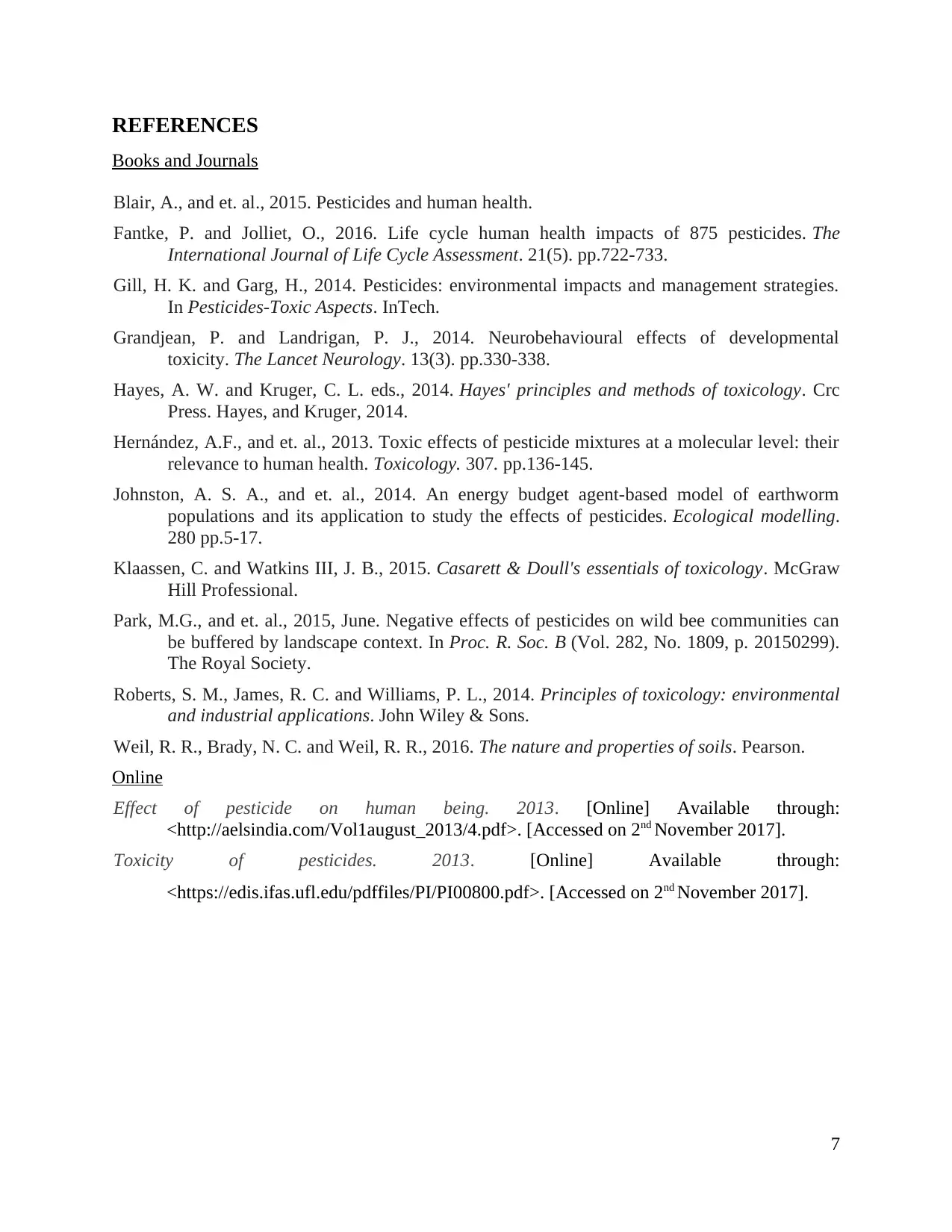
REFERENCES
Books and Journals
Blair, A., and et. al., 2015. Pesticides and human health.
Fantke, P. and Jolliet, O., 2016. Life cycle human health impacts of 875 pesticides. The
International Journal of Life Cycle Assessment. 21(5). pp.722-733.
Gill, H. K. and Garg, H., 2014. Pesticides: environmental impacts and management strategies.
In Pesticides-Toxic Aspects. InTech.
Grandjean, P. and Landrigan, P. J., 2014. Neurobehavioural effects of developmental
toxicity. The Lancet Neurology. 13(3). pp.330-338.
Hayes, A. W. and Kruger, C. L. eds., 2014. Hayes' principles and methods of toxicology. Crc
Press. Hayes, and Kruger, 2014.
Hernández, A.F., and et. al., 2013. Toxic effects of pesticide mixtures at a molecular level: their
relevance to human health. Toxicology. 307. pp.136-145.
Johnston, A. S. A., and et. al., 2014. An energy budget agent-based model of earthworm
populations and its application to study the effects of pesticides. Ecological modelling.
280 pp.5-17.
Klaassen, C. and Watkins III, J. B., 2015. Casarett & Doull's essentials of toxicology. McGraw
Hill Professional.
Park, M.G., and et. al., 2015, June. Negative effects of pesticides on wild bee communities can
be buffered by landscape context. In Proc. R. Soc. B (Vol. 282, No. 1809, p. 20150299).
The Royal Society.
Roberts, S. M., James, R. C. and Williams, P. L., 2014. Principles of toxicology: environmental
and industrial applications. John Wiley & Sons.
Weil, R. R., Brady, N. C. and Weil, R. R., 2016. The nature and properties of soils. Pearson.
Online
Effect of pesticide on human being. 2013. [Online] Available through:
<http://aelsindia.com/Vol1august_2013/4.pdf>. [Accessed on 2nd November 2017].
Toxicity of pesticides. 2013. [Online] Available through:
<https://edis.ifas.ufl.edu/pdffiles/PI/PI00800.pdf>. [Accessed on 2nd November 2017].
7
Books and Journals
Blair, A., and et. al., 2015. Pesticides and human health.
Fantke, P. and Jolliet, O., 2016. Life cycle human health impacts of 875 pesticides. The
International Journal of Life Cycle Assessment. 21(5). pp.722-733.
Gill, H. K. and Garg, H., 2014. Pesticides: environmental impacts and management strategies.
In Pesticides-Toxic Aspects. InTech.
Grandjean, P. and Landrigan, P. J., 2014. Neurobehavioural effects of developmental
toxicity. The Lancet Neurology. 13(3). pp.330-338.
Hayes, A. W. and Kruger, C. L. eds., 2014. Hayes' principles and methods of toxicology. Crc
Press. Hayes, and Kruger, 2014.
Hernández, A.F., and et. al., 2013. Toxic effects of pesticide mixtures at a molecular level: their
relevance to human health. Toxicology. 307. pp.136-145.
Johnston, A. S. A., and et. al., 2014. An energy budget agent-based model of earthworm
populations and its application to study the effects of pesticides. Ecological modelling.
280 pp.5-17.
Klaassen, C. and Watkins III, J. B., 2015. Casarett & Doull's essentials of toxicology. McGraw
Hill Professional.
Park, M.G., and et. al., 2015, June. Negative effects of pesticides on wild bee communities can
be buffered by landscape context. In Proc. R. Soc. B (Vol. 282, No. 1809, p. 20150299).
The Royal Society.
Roberts, S. M., James, R. C. and Williams, P. L., 2014. Principles of toxicology: environmental
and industrial applications. John Wiley & Sons.
Weil, R. R., Brady, N. C. and Weil, R. R., 2016. The nature and properties of soils. Pearson.
Online
Effect of pesticide on human being. 2013. [Online] Available through:
<http://aelsindia.com/Vol1august_2013/4.pdf>. [Accessed on 2nd November 2017].
Toxicity of pesticides. 2013. [Online] Available through:
<https://edis.ifas.ufl.edu/pdffiles/PI/PI00800.pdf>. [Accessed on 2nd November 2017].
7
⊘ This is a preview!⊘
Do you want full access?
Subscribe today to unlock all pages.

Trusted by 1+ million students worldwide
1 out of 9
Related Documents
Your All-in-One AI-Powered Toolkit for Academic Success.
+13062052269
info@desklib.com
Available 24*7 on WhatsApp / Email
![[object Object]](/_next/static/media/star-bottom.7253800d.svg)
Unlock your academic potential
Copyright © 2020–2025 A2Z Services. All Rights Reserved. Developed and managed by ZUCOL.




